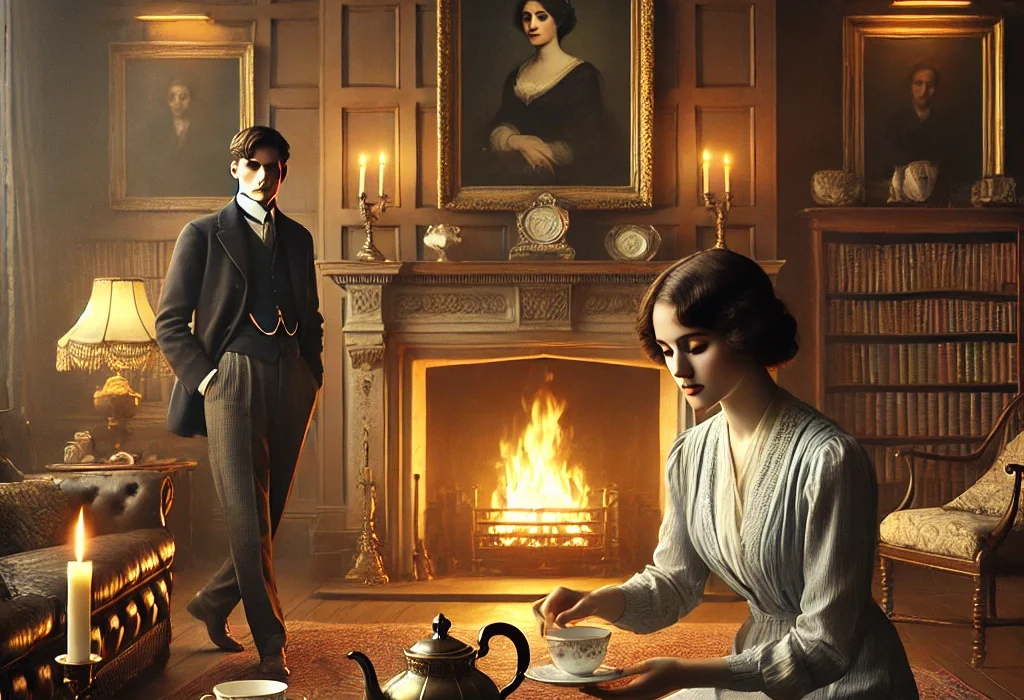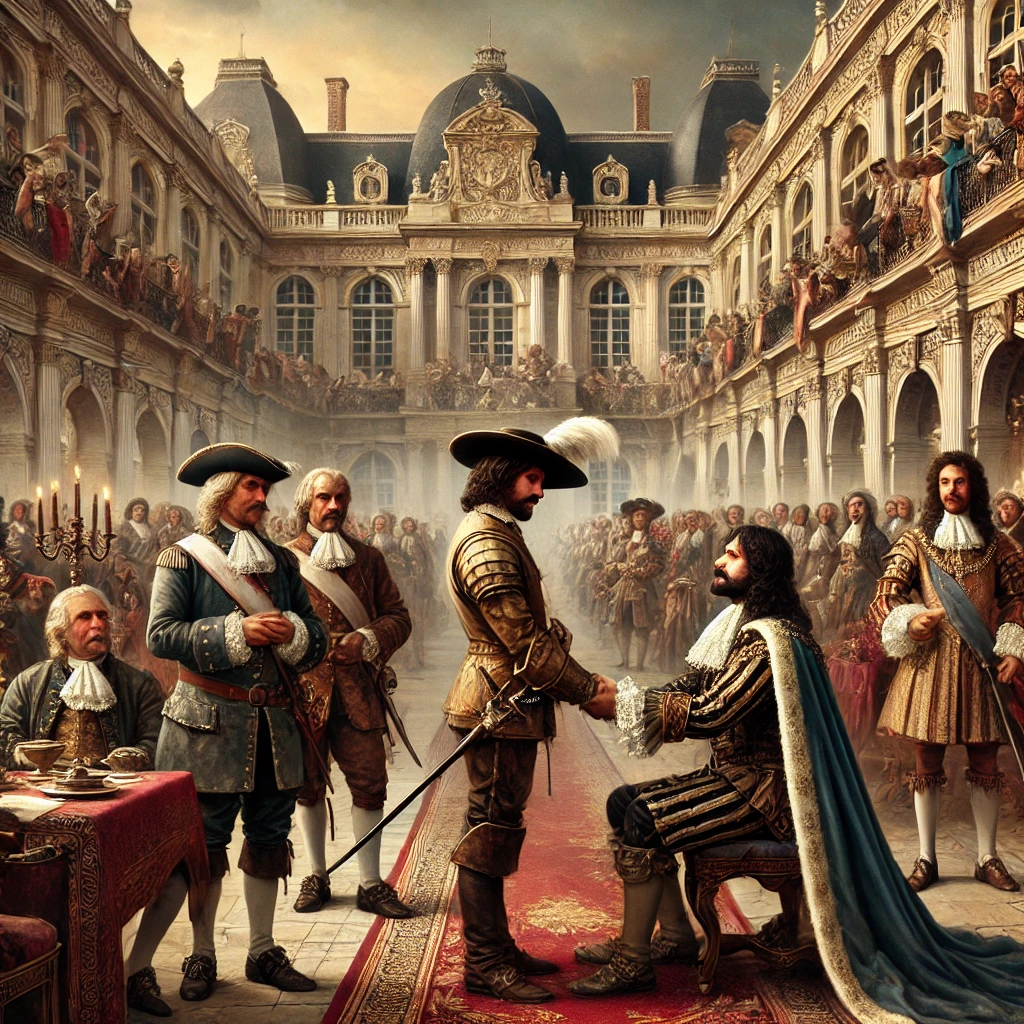Virginia Woolf’s Night and Day, published in 1919, unfolds in Edwardian London, where the intersections of love, ambition, and societal expectations come to a head. Woolf examines the personal dilemmas of love and career while critiquing social norms, especially concerning women’s independence. This early work of Woolf lacks the experimental stream-of-consciousness style of her later novels but captures a nuanced portrayal of early 20th-century English society, exploring romance and identity against a background of social reform and traditional values.
Plot Summary
On an October evening in London, Katharine Hilbery presides over a tea party in her family’s elegant parlor, a gathering filled with prominent guests who marvel at the relics and paintings of Katharine’s grandfather, the great poet Richard Alardyce. She is graceful, thoughtful, and seemingly the perfect hostess, though within her quiet gaze and reserved demeanor lies a discontent unspoken. A life filled with parlor conversations, family reverence for an illustrious past, and endless discussions about her grandfather’s biography weighs on her; she yearns for a sense of direction in her own life.
Among the guests is Ralph Denham, a self-made lawyer with a modest background, far removed from the refined world of the Hilberys. Ralph is both intrigued and unsettled by Katharine’s beauty and aloofness. Beneath her calm exterior, he senses an uncharted landscape of intelligence and ambition. The disparity in their social status initially places a wall between them, and Ralph feels both captivated and challenged by Katharine’s detached manner. Leaving the Hilbery home that evening, he feels he has encountered something beyond his control—an attraction that awakens in him both frustration and fascination.
Katharine’s family, particularly her mother, Mrs. Hilbery, is devoted to the task of compiling Richard Alardyce’s biography. For years, Mrs. Hilbery has scattered about the house notes and drafts that could give shape to her father’s life story, but her romanticized view of his legacy leaves the work endlessly unfinished. It falls to Katharine to organize her mother’s writing and manage the biography’s progress. Amid the clutter of papers and anecdotes, Katharine’s patience frays, and her own dreams and ambitions are forced into the background. She questions her role and the limitations it imposes, doubting if the dutiful daughter’s life is the one she truly wants.
During this time, Katharine becomes engaged to William Rodney, an unremarkable yet sincere poet whose affections for her seem grounded in a romantic ideal rather than true understanding. William’s passions, though genuine, lack the depth that Katharine craves. He imagines Katharine as a literary muse or an ornament for his own aspirations, unable to see beyond her composed exterior. Yet Katharine, constrained by familial duty and social expectations, finds herself unable to refuse his proposal outright. She consents to the engagement, feeling the security it offers but already sensing the confinement it entails.
Mary Datchet, a passionate suffragette and mutual friend, provides an alternative view of life and independence. Living alone and dedicated to her political work, Mary offers Katharine a vision of autonomy and purpose that sharply contrasts the constraints of her own life. Yet Mary herself faces her own longing, having secretly fallen in love with Ralph. Her unspoken affection for him and her understanding of his struggles reveal the quiet sacrifices she has made for her ideals.
Ralph, meanwhile, is drawn deeper into Katharine’s world, and his growing affection for her becomes both a source of anguish and inspiration. He yearns for her attention, his admiration for her intelligence and beauty sparking a desire he struggles to reconcile with his pride. He resents the world of privilege Katharine represents, yet he cannot escape the magnetism she exerts over him. As Ralph attempts to reconcile his feelings, his resentment and longing build, driving him to challenge Katharine on the superficiality of her life and her entrapment within her family’s legacy.
During a walk through London, Ralph confronts Katharine directly, challenging her lack of direction and questioning her engagement to William. Katharine listens, and his words strike a chord, uncovering a truth she has barely acknowledged. His voice brings to life a desire she has long stifled, and an unexpected intimacy emerges between them. Katharine feels, perhaps for the first time, understood by someone outside her world, and Ralph’s frustration mirrors her own suppressed anger at her entrapment. She begins to question her engagement and the life of convention it promises.
Katharine eventually confides in her mother about her doubts, breaking free from the imposed narrative that has shaped her life. Mrs. Hilbery, initially shocked, softens with understanding and even expresses regret over the family’s pressure on Katharine. With her mother’s blessing, Katharine breaks off her engagement to William, a decision met with William’s pain and confusion. William’s grief exposes Katharine’s own struggle between familial duty and her nascent sense of independence, but she remains firm, knowing that her decision aligns with her true self.
As Katharine moves closer to Ralph, their relationship grows increasingly charged. For both, the union represents a confrontation with their inner fears and the possibility of a future unbound by social class or obligation. Ralph’s admiration for Katharine’s intelligence fuels his own ambitions, while Katharine finds in Ralph a partner who shares her search for purpose. Yet they both struggle with the reality of bridging the gap between their backgrounds and their differing ambitions. Their love, although powerful, is tested by their individual needs for independence.
When Katharine decides to pursue mathematics, a discipline that represents clarity and order in contrast to the vague reverence of her family’s literary past, she finally asserts her own desires. Mathematics, to Katharine, offers a form of intellectual freedom that surpasses the stifling confinement of her heritage. Ralph, although unsettled by her decision, respects her determination, recognizing that her choice allows her to define herself beyond the expectations of family and society.
In time, Katharine and Ralph’s love evolves from romantic attraction into a more tempered, realistic bond. They understand that they can respect each other’s independence while sharing a commitment to mutual growth. Katharine’s departure from her engagement to William, her renouncement of her family’s obsession with legacy, and her embrace of her own path liberate her to explore a life of her choosing. The two stand not as figures within their traditional social roles but as individuals determined to shape their futures on their own terms.
Katharine and Ralph remain bound by a connection rooted not just in love but in mutual recognition and respect. Each offers the other a refuge from society’s strictures and a partner in their shared desire for meaning. Though they face an uncertain future, their journey has redefined their understanding of love, independence, and personal freedom, allowing them to walk forward into a life of their own creation.
Main Characters
Katharine Hilbery: The intellectual granddaughter of a famous poet, Katharine is elegant, thoughtful, and often contemplative. She struggles with societal expectations, the weight of her literary heritage, and her own desire for a life that transcends conventional roles. Her journey centers on balancing family expectations and her personal aspirations, making her a complex and multi-layered character.
Ralph Denham: An ambitious young lawyer, Ralph embodies a practical and realistic worldview, often contrasting with the romantic and privileged life of the Hilberys. His attraction to Katharine is both an inspiration and a source of internal conflict as he navigates his feelings for her against his class insecurities and professional ambitions.
Mary Datchet: A suffragette and advocate for women’s rights, Mary is strong-willed, independent, and deeply invested in social causes. Her unrequited love for Ralph adds an emotional depth to her character and reflects the societal limitations placed on women at the time.
William Rodney: A poet and suitor to Katharine, William is often portrayed as overly romantic and somewhat naive. His affection for Katharine highlights the tension between romantic idealism and practical compatibility, adding a layer of complexity to the narrative’s romantic entanglements.
Theme
Love vs. Independence: Woolf explores how love and personal freedom often clash, especially for women who desire intellectual or professional autonomy. The novel suggests that love, as traditionally understood, can restrict personal growth, yet it also offers companionship and fulfillment.
Societal Expectations and Individual Aspirations: Characters like Katharine and Ralph grapple with societal pressures that dictate their roles, family obligations, and career paths. Woolf critiques the class-based norms that stifle individuality and the traditional expectations that frame marriage as a primary goal for women.
Feminism and Social Reform: Through Mary Datchet’s character and her work as a suffragette, Woolf introduces feminist ideas, advocating for women’s political engagement and equality. This theme mirrors the era’s evolving views on gender roles and reflects Woolf’s own advocacy for women’s independence.
The Weight of Legacy: The Hilberys’ devotion to their literary heritage, specifically Katharine’s connection to her famous grandfather, explores the impact of familial legacy on one’s identity. The theme suggests that a prestigious background, while admirable, can also be a burden, especially when it overshadows one’s personal identity.
Writing Style and Tone
In Night and Day, Woolf employs a reserved yet observant tone, one that conveys the quiet tensions simmering beneath her characters’ polite interactions. Her prose in this novel is notably more traditional than her later work; she uses linear narrative structure and realistic dialogues that reflect the Edwardian society’s conservative values and the characters’ internal conflicts. Woolf’s language is rich with insight into both her characters’ inner lives and their relationships, as she subtly critiques the social structures constraining them.
Woolf’s style in Night and Day is both poetic and meticulous. Her descriptive language often serves to contrast the restrained outward lives of her characters with their vivid internal landscapes. While Night and Day lacks the fluid stream-of-consciousness narration of To the Lighthouse or Mrs Dalloway, Woolf’s nuanced character portrayals and her insights into the psychological complexities of love, duty, and ambition foreshadow the depth of her later works.
We hope this summary has sparked your interest and would appreciate you following Celsius 233 on social media:
There’s a treasure trove of other fascinating book summaries waiting for you. Check out our collection of stories that inspire, thrill, and provoke thought, just like this one by checking out the Book Shelf or the Library
Remember, while our summaries capture the essence, they can never replace the full experience of reading the book. If this summary intrigued you, consider diving into the complete story – buy the book and immerse yourself in the author’s original work.
If you want to request a book summary, click here.
When Saurabh is not working/watching football/reading books/traveling, you can reach him via Twitter/X, LinkedIn, or Threads
Restart reading!








